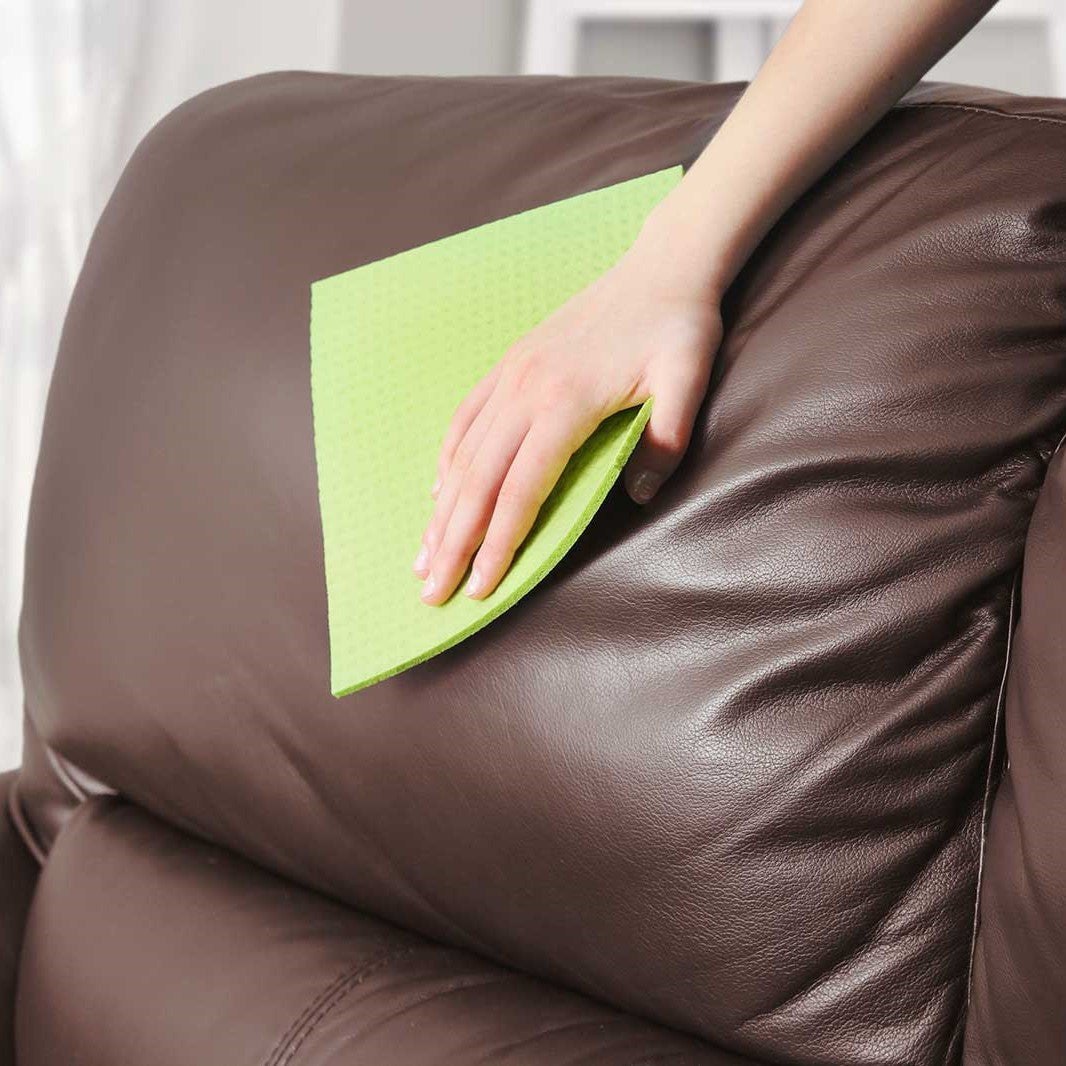A leather couch exudes timeless charm, but when mold begins to appear, that elegance quickly fades. Mold and mildew thrive in damp, poorly ventilated spaces, making leather furniture especially vulnerable. If you’re facing this issue, you should know how to clean mildew off leather properly to avoid permanent damage. Fortunately, there are proven methods to remove mould from leather while preserving its supple texture and natural sheen. This guide provides step-by-step instructions for getting mold off leather, using both household solutions and professional tips. With the right care, your leather couch can be beautifully restored and protected from future outbreaks.
Identifying Mold on a Leather Couch
To begin addressing the problem of mold, one must first recognize its unwelcome presence. Carefully observe your leather couch for early warning signs, these may appear as dark speckles, faded patches, or a lingering musty odor that clings to the upholstery. Such clues often indicate that mold has already begun to spread. Since mold thrives in damp, humid conditions, timely identification is essential. Acting swiftly not only prevents structural damage but also makes the process of getting mold off leather significantly more manageable.
Despite its refined appeal, even a luxury leather sofa is not exempt from environmental vulnerabilities. Moisture trapped in cushions, poor airflow in confined spaces, or previous exposure to liquid spills can all invite mold to develop silently over time. The sooner you spot these subtle indicators, the easier it becomes to preserve the integrity, texture, and elegance of your cherished leather piece.

Mold may include dark speckles, uneven fading, or a persistent musty odor embedded in the upholstery.
What Causes Mold Growth on Leather?
Mold doesn't just happen overnight, it develops gradually under specific environmental conditions. By identifying these triggers early, you can prevent damage and reduce the likelihood of getting mold off leather becoming a recurring challenge. This is particularly important if you’re furnishing your home with a modern sofa set or investing in timeless pieces like modern dining tables, where both aesthetic and material quality deserve long-term care and protection.
1. Damp Conditions
One of the most common culprits behind mold growth is moisture. Excess humidity in the air or direct contact with water, such as spills, steam, or flooding, creates the perfect environment for mold to flourish on leather surfaces. When a leather sofa absorbs this moisture and lacks ventilation, mold spores settle and begin to grow, often unnoticed until visible signs appear.
2. Ambient Temperatures
Mold thrives in moderate, stable temperatures, particularly between 60°F and 80°F (15°C to 27°C). When a leather couch is kept in rooms where these conditions persist without airflow or dehumidification, the risk of mold increases. Even high-end materials in a modern sofa set can fall victim to this if the climate is not carefully controlled.
3. Lack of Sunlight
Natural sunlight plays a quiet yet powerful role in preventing mold. Leather furniture placed in dark, shaded areas such as basements, closed living rooms, or corners with drawn curtains, misses the drying and antimicrobial effect of UV rays. This absence of light gives mold spores the freedom to multiply, making getting mold off leather more difficult in the long run.
4. Lack of Use and Care
Another factor that contributes to mold growth is neglect. When a leather sofa is seldom used and rarely cleaned, it becomes vulnerable to mold infestation. Dust and dirt begin to settle into the pores of the leather, while unnoticed moisture quietly seeps in. Over time, this creates the ideal conditions for mold to flourish. Without routine upkeep, getting mold off leather becomes a much harder task. Regular use, along with gentle cleaning, helps prevent the buildup that mold thrives on.
5. Moldy Water
Exposure to contaminated water is another serious risk. During events such as flooding or plumbing leaks, your leather couch may come into contact with mold-infested water. When this happens, spores can immediately adhere to the leather surface and multiply rapidly. Knowing how to clean mold off leather promptly after such exposure is essential to stop the spread and preserve the material. Ignoring even a minor incident involving moldy water could result in long-term damage and health concerns.
6. Stored With Other Molded Items
Storage conditions also play a crucial role. If your leather sofa is placed near objects that have already been affected by mold, whether in a garage, basement, or storage unit, the spores can easily transfer. Mold does not need direct contact with moisture to spread; airborne spores are enough to initiate growth. To prevent this, never store your leather furniture near contaminated items. Should cross-contamination occur, you'll need to remove mould from leather quickly and thoroughly to avoid a deeper infestation.

Protecting your leather couch to ensure a clean and safe living environment for you and your family.
How to Remove Mold from a Leather Couch?
Learning how to clean mold off leather will save both time and expense. Moreover, understanding how to remove mould from leather allows you to extend the life of your furniture while keeping your living space fresh and stylish.
Dry Brushing or Vacuuming
Before diving into any deep cleaning, begin by gently dry brushing or vacuuming the affected parts of the couch. Use a soft-bristled brush or a vacuum cleaner with a brush attachment to remove loose mold spores on the surface. This step is essential because it prevents mold from spreading further during the next stages. Starting with a clean, dry surface sets the foundation for successfully getting mold off leather without embedding it deeper into the material.
Cleaning the Leather Surface
Once surface spores are removed, prepare a gentle solution using mild soap and warm water. Lightly dampen a microfiber cloth or sponge with the solution, and carefully wipe down the mold-affected areas. Be cautious not to oversaturate the leather, as excessive moisture can worsen the problem. A soft touch is critical, vigorous scrubbing can damage the texture and finish of the leather.
As an added bonus, this cleaning method also helps tackle lingering pet odors. If you’ve been wondering whether the same process works for pet-related smells, the answer is yes. The combination of mild soap and water can help eliminate those stubborn scents while you remove mould from leather.
Treating Stubborn Mold Stains
When soap and water alone aren’t enough, you may need a stronger solution. For persistent stains, mix equal parts rubbing alcohol and water. Lightly moisten a clean cloth with the solution and gently dab the stained area. Always test this on a hidden section first to check for any adverse effects. Done carefully, this method can lift deeply embedded mold while preserving the leather’s integrity.
At the same time, this might be the moment to rethink your home’s interior design. If you're planning a refresh, consider pairing your cleaned space with a modern sofa set. These pieces bring a clean, stylish aesthetic to your home and pair beautifully with thoughtful dining room set ideas, creating a cohesive and inviting atmosphere.
Conditioning the Leather
After mold removal, it’s important not to skip conditioning. Mold-cleaning solutions can strip the leather of its natural oils, so replenishing them is essential. Use a high-quality leather conditioner and apply it evenly across the entire surface. This step restores softness, improves durability, and helps prevent future mold buildup by maintaining a healthy moisture balance.
For those who appreciate comfort without compromising elegance, investing in a luxury leather sofa can elevate your space. These premium pieces, when cared for properly, stand the test of time. Regular maintenance, including conditioning and cleaning, ensures that your investment remains free from damage and that you won’t have to worry about getting mold off leather again anytime soon.

Brushing or vacuuming the impacted regions of your leather couch will eliminate loose mold spores.
How to Prevent Mold on Leather Sofa
Prevention remains the most effective and least time-consuming strategy. Mold is much easier to avoid than to eliminate once it takes hold, especially on delicate materials like leather. Taking proactive steps not only helps in maintaining the appearance and longevity of your furniture but also spares you the trouble of getting mold off leather after it has already spread.
- Avoid positioning it in areas prone to high humidity, such as basements, enclosed laundry rooms, or near leaky windows. Leather is a natural material that readily absorbs moisture, creating the ideal environment for mold to thrive. If you’ve already encountered this issue, understanding how to clean mildew off leather will help you reverse the damage but keeping it away from damp environments is the best line of defense.
- Make sure your living space is well-ventilated by opening windows regularly or using fans to promote circulation. Avoid leaving wet clothing, towels, or bags on the leather surface, as even short-term exposure can trigger mold growth. These small habits, when practiced consistently, can greatly reduce the need to remove mould from leather later.
- Dust and dirt can trap moisture, creating microenvironments where mold begins to develop. Use a soft, dry cloth to wipe down your leather sofa weekly. Not only does this keep the surface clean, but it also gives you a chance to catch early signs of mold before they become a serious problem. This habit reinforces everything you’ve learned about how to clean mildew off leather by helping you avoid that task in the first place.
- Control the room’s humidity levels with a dehumidifier or moisture-absorbing products such as silica gel or activated charcoal. These tools are especially helpful during rainy seasons or in naturally humid climates. By keeping ambient moisture low, you’ll drastically cut down the chances of needing to learn how to clean mold off leather again. Preventive care is not only practical but also preserves the elegance and durability of your leather investment.

Proper care can help to remove mold on the sofa, ensuring that you can enjoy its comfort and beauty for years to come.
FAQs
1. What is Mold?
Mold is a living fungus that thrives in warm, humid, and poorly ventilated environments. It spreads rapidly by releasing microscopic spores into the air, often going unnoticed until visible signs appear. On leather surfaces, mold can take the form of fuzzy green or black patches, blotchy discoloration, or a persistent musty smell.
When left untreated, mold can deteriorate the texture and structure of leather, making getting mold off leather more challenging over time. In addition to damaging your furniture, mold can affect indoor air quality, which is why knowing how to clean mildew off leather is crucial for both the longevity of your sofa and the health of your household.
2. Is Mold That Grows On Leather Dangerous?
Mold on leather is not just an aesthetic issue, it can also pose real health risks, especially to individuals with allergies, asthma, or weakened immune systems. Certain strains of mold can release spores and mycotoxins that irritate the respiratory tract, trigger skin reactions, or lead to persistent coughing and sneezing. Even a small patch on a sofa can circulate spores throughout your home if not handled properly. That’s why it’s vital to act quickly and learn how to clean mold off leather safely and thoroughly. Taking the right steps early on not only protects your health but also reduces the need for deep restoration later.
Dealing with mold on your leather couch can be frustrating, but with the right approach, it’s entirely manageable. By following the proper steps on how to clean mold off leather, you can restore your furniture’s beauty and prevent future issues. Understanding the process of getting mold off leather helps maintain a healthy home and a stylish living space. And if you’re ready to upgrade, explore COZY’s collection of high-quality sofas or choose a timeless dining table 8 seater set for lasting elegance.





